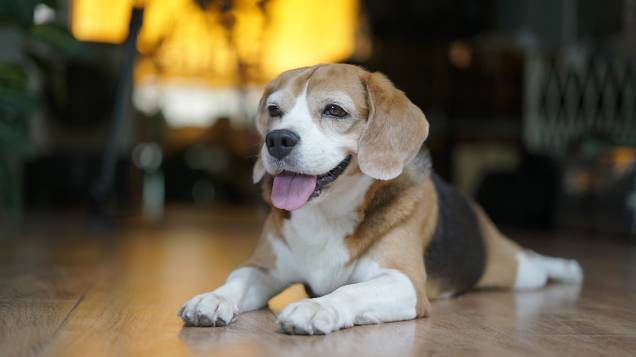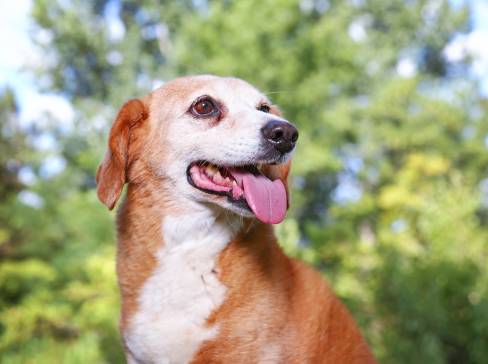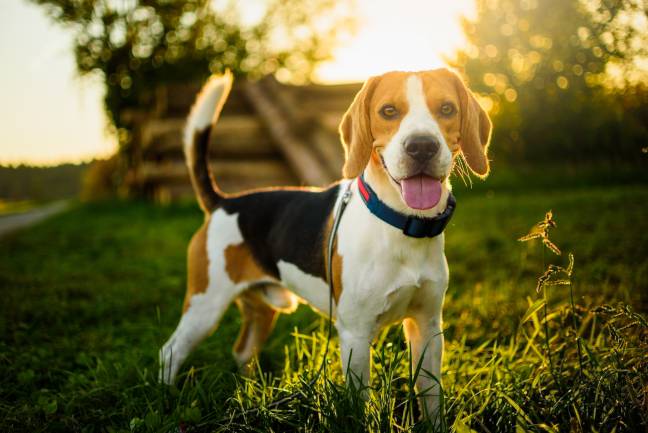Connect with a verified veterinarian in minutes. Licensed vets are available 24/7 to answer your questions. No need to worry about your furry family member.
Most people are familiar with Beagles! These are one of the most popular dogs in the US! However, have you ever heard of the Pocket Beagle? If not, you may want to read on to learn more about these other kinds of Beagles.
We’ve put together some information about Pocket Beagles and how they differ from regular Beagles. This way, you’ll have the information you need to decide if the Pocket Beagle is the right dog for you and your family to adopt. Let’s get started!
What is a Pocket Beagle?
The Pocket Beagle is a miniaturized version of the standard Beagle we all know and love. These dogs are small! And they’re adorable, with their dark hazel eyes and appealing faces. These small dogs are pretty similar to their larger Beagle cousin.
Pocket Beagles usually get along with other animals and humans. And these dogs are scent hounds, like their larger cousins. They have excellent noses that can sniff out just about anything. The dogs are also gentle and have a sweet nature. They’re also highly intelligent and can be quite the clown!
And like their larger Beagle cousins, Pocket Beagles need to be trained and socialized from a young age. They should not be spoiled, though we understand it would be easy to do so! But a Pocket Beagle needs to be a well-behaved dog with the confidence and the understanding of how to react to different situations and people. To achieve these qualities, the dogs must be trained and socialized early.
Pocket Beagle Health Issues
Like other dog breeds, Pocket Beagles are prone to certain health issues, including:
- Eye problems (glaucoma, cataracts, and more)
- Epilepsy
- Hypothyroidism
- Beagle dwarfism
- Chinese Beagle syndrome
- Cryptorchidism
- Hermaphroditism
- Hip dysplasia
- Intervertebral disc disease
- Patellar luxation

Review symptoms, medications & behavior to keep your pets healthy with a Vet Online in just minutes.
Ask a Vet Live NowHow are Pocket Beagles Different Than Beagles?
Here’s a chart to give you an overview of how the Pocket Beagle and the Beagle differ
| Pocket Beagle | Beagle | |
| Average Height | 7-12 inches | 15 inches |
| Average Weight | 7-15 lbs | 20-25 lbs |
| Lifespan | 7-9 years | 12-15 years |
| Exercise | These dogs have a moderate amount of energy and love to be outside | These dogs have moderate to high levels of energy and love to play outside |
| Grooming Requirements | Moderate to high | Moderate to high |
| Family Companions | Yes, very friendly | Yes, very friendly |
| Friendly with Other Dogs | Yes | Yes |
| Trainability | Highly trainable and intelligent | Highly trainable and intelligent |
As you can see, the major differences between the Pocket Beagle and the Beagle are their size, weight, and life spans. What’s more, the Pocket Beagle is not recognized by the AKC (American Kennel Club). However, if the Pocket Beagle is about the same size as a standard Beagle, they can be classified as a regular Beagle.
How Pocket Beagles are Developed
Breeders use several methods to develop these pocket-sized Beagles.
1. Pocket Beagle Mixes
One of the breeding methods to develop Pocket Beagles is to breed a purebred Beagle with a smaller dog that has a similar look to the Beagle. This is also a great way to increase genetic diversity within the breed.
Pocket Beagles that are hybrid mixes can be healthier; however, the dogs can also inherit health issues from their other parent.
Another problem with this method is that a breeder may not tell the pet parent this Pocket Beagle is a hybrid dog rather than a purebred Beagle.
2. Dwarf Pocket Beagles
Another method breeders may use is to breed a miniature dog to intentionally introduce the dwarfism gene into their bloodlines and then selectively breed that gene.
Dwarfism is common in Beagles, so this may be one of the most common methods used by breeders. This gene doesn’t necessarily mean a dog will have health issues. However, it can be a problem, especially if the dog has severe dwarfism symptoms.
This condition can lead to bowed limbs, joint issues, spinal abnormalities, and other health issues. Dwarfism at this level usually causes a life of pain and stress for the dog, along with expensive vet bills for the pet parent.
3. Breeding Pocket Beagles from Runts
The last method a breeder may choose to breed Pocket Beagles is to breed runts together. This doesn’t necessarily mean the small dogs will have health issues. However, experts have seen higher rates of health problems in runts compared to their normal-sized, healthy cousins.
Breeders may also use a combination of these methods to develop Pocket Beagles. And these breeding methods can carry a higher rate of health issues in Pocket Beagles. It really depends on the breeder and how they breed their dogs.
Pocket Beagle vs. Beagle Temperament
Pocket Beagles and Beagles generally have the same temperament. Both dogs are sweet-natured, friendly, playful, and happy dogs. Because Beagles were bred to be pack dogs, they tend to get along well with other dogs and cats. And they love spending time with their families.
While Pocket Beagles can make wonderful family companions, they’re not recommended for families that have kids. That’s because these dogs are very small, and kids (especially young kids) may play too rough for the dogs.
Like their larger Beagle cousins, Pocket Beagles also easily become bored and lonely. When they’re bored or lonely, a Pocket Beagle can become destructive. These dogs need lots of training and attention to prevent them from developing these issues.
Pocket Beagles vs. Beagles Appearance
Pocket Beagles strongly resemble Beagles; however, they can have a slightly different appearance. For one thing, these smaller Beagles have a narrower muzzle, and their body may not be in proportion. The dogs may have legs that are short and bowed, with stomachs that may look distended.
In addition, Pocket Beagles usually have a wider head and bulging eyes, along with an underbite and a protruding tongue.
Do Pocket Beagles Shed?
Yes, the Pocket Beagle can shed like their larger cousin. However, if the Pocket Beagle is a hybrid dog that was crossbred with a Poodle (for example), the dog won’t shed as much as a regular Beagle.
Summing It Up
As you can see, Pocket Beagles and Beagles have a lot in common; however, there are also some differences between them, too. For one thing, Pocket Beagles are smaller than Beagles. They can also be friendly, energetic dogs.
However, keep in mind that some of the breeding practices used to create these diminutive dogs can lead to major health issues. What’s more, these small dogs are not recommended for kids.
But if you’re looking for a small dog that is much like a Beagle, you may want to consider a Pocket Beagle. Just be aware that you may face expensive vet bills with this adorable small dog!
Connect with a verified veterinarian in minutes. Licensed vets are available 24/7 to answer your questions. No need to worry about your furry family member.

Kim
Kim is a talented author, who loves animals especially dogs. She engaged in writing books and articles relating to animals a decade ago. Kim resides in Chicago with her husband and son. The family is the proud owner of a dog and a parrot (Jack and Lily). Kim wanted more than these two pets, but her husband put his foot down... She often visits elementary schools to talk to the kids about what she learned about pets and how they could learn from them.
Review symptoms, medications & behavior to keep your pets healthy with a Vet Online in just minutes.
Ask a Vet Live Now




